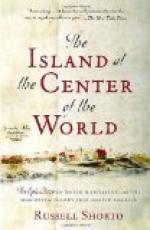But now there came another great fire. On a December night, a night so cold that it was said there had not been such another in fifty years, flames broke out in the lower part of town near the river. The citizens battled with it as best they could, but it burned for three days, destroying almost all of the business end of the city. For years afterward it was called the “Great Fire,” and was remembered with dread. To-day there is a marble tablet on a house in Pearl Street near Coenties Slip, which was the centre of the burned district, where you can read of how fearful the fire was and how thankful the people were that the entire city was not destroyed. But the houses were quickly rebuilt, and New York prospered more than ever before.
[Illustration: View of Park Row, 1825.]
Destructive as the fire was, however, it called attention to the fact that there was a woful lack of water in the city. Most of the water was still supplied by the wells and springs which had been sufficient for a small town, but were by no means so for a city of the present size. It was now that the idea of bringing a large supply of water from without the city was conceived. The plan was to build an artificial course, or aqueduct, for water, from the Croton River, forty miles and more above the city. Many thought that this was not possible, but then other seemingly impossible things had been accomplished, so they pushed ahead and commenced the building of this work. A dam was thrown across the Croton River, forming a lake five miles long. The aqueduct extended from this dam to the city. Sometimes it had to be cut through the solid rock; sometimes it was continued underground by tunnel; sometimes over valleys by embankments, until at last it reached the Harlem River where a stone bridge, called the High Bridge, was built to support it. Through this channel of solid masonry the water was brought into the city, and when it reached the Island of Manhattan was distributed in pipes over the entire city. This wonderful work cost $9,000,000, and took seven years to build. When the water was first released from Croton River and flowed into the new channel, rushing along for forty miles to the city, the citizens rejoiced greatly. There was a celebration with parades and illuminations.
[Illustration: High Bridge, Croton Aqueduct.]
It now looked as though there would be enough water to last no matter how large the city should become, for there were now 95,000,000 gallons a day available. But before another fifty years had passed there was a cry for more water, But this time the people knew just what to do, and another aqueduct was built from the Croton River. This one was carried under the Harlem River instead of over it, supplying so much water that it will doubtless be many a long year indeed before another will be needed.
CHAPTER XXXIX
Professor Morse and the telegraph




